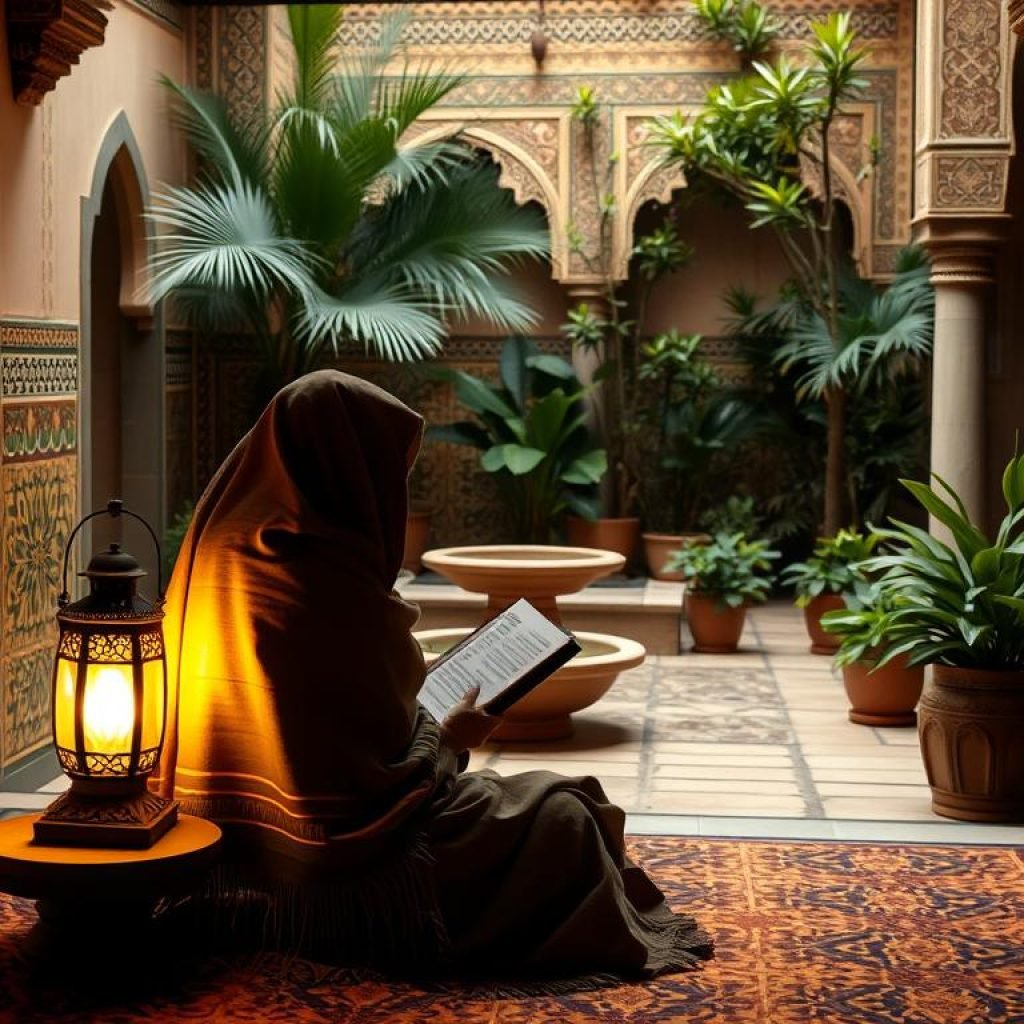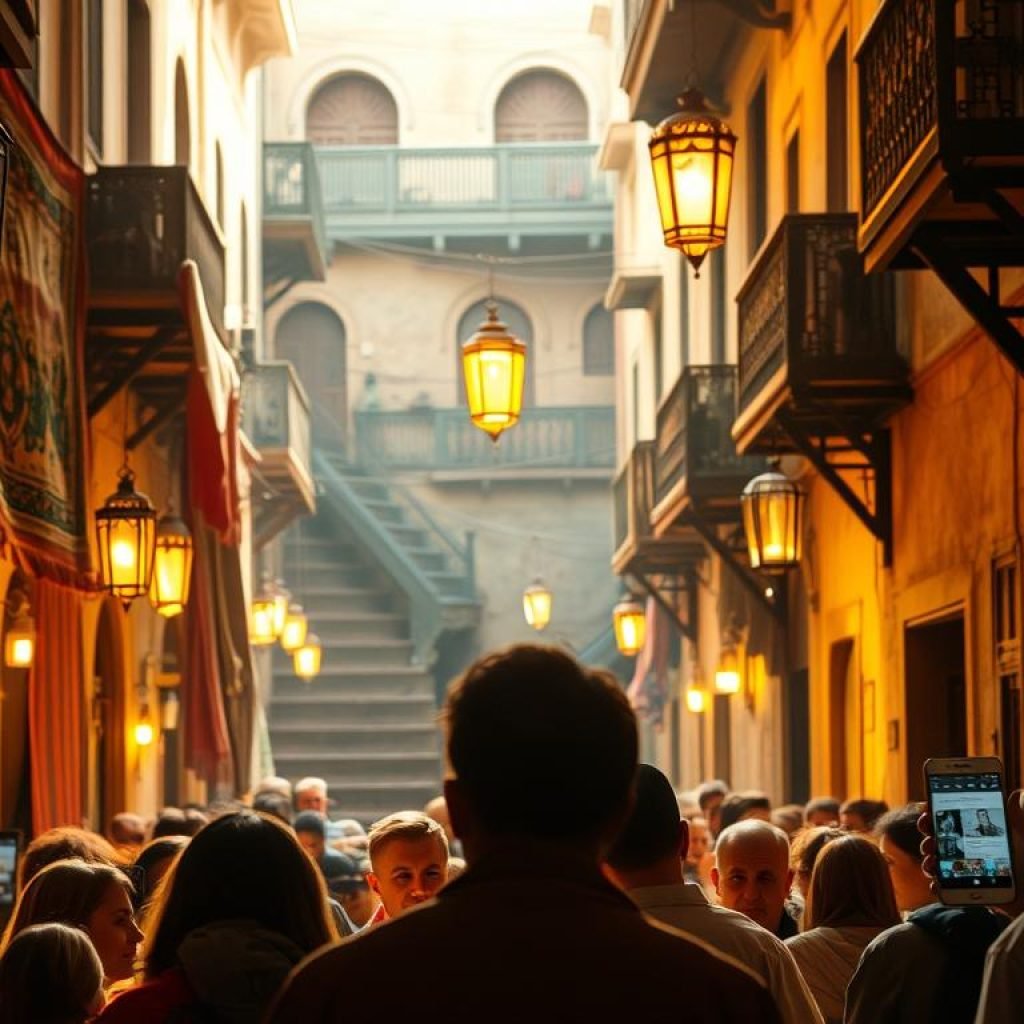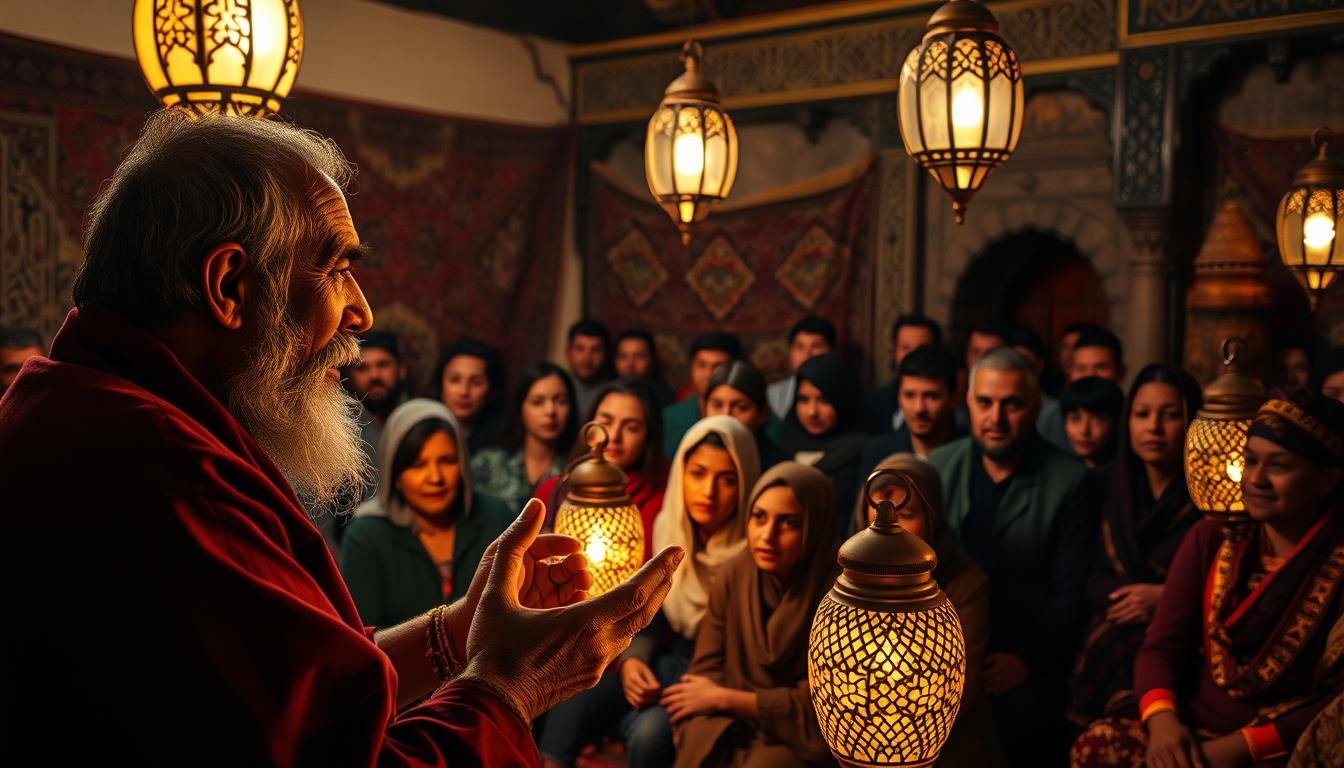What role does Moroccan culture play in keeping traditional tales alive? How can we learn from the ancient art of hikayat? Moroccan storytelling has been a key part of the country’s heritage for over 1,000 years. It has passed down information, moral messages, and entertainment through generations.
The tradition of oral storytelling in Morocco is unique and vital to its culture.
The Rich Heritage of Moroccan Storytelling
Moroccan storytelling, or hikayat, has been a cornerstone of Moroccan culture for over a thousand years. It has its roots in oral tradition and has been influenced by diverse cultures. This traditional storytelling has been crucial for entertainment, education, and preserving culture. Storytellers have played a key role in sharing stories and moral lessons.
Key Takeaways
- Moroccan storytelling, or hikayat, is a traditional form of storytelling that has been passed down for generations.
- The art of hikayat is a unique and essential part of Moroccan culture, with its roots in oral tradition and influence from diverse cultures.
- Moroccan storytelling has been an important means of entertainment, education, and cultural preservation.
- The tradition of oral storytelling in Morocco is in danger of becoming extinct due to technological advancements.
- Efforts are being made to preserve and promote Moroccan storytelling, including the International Storytelling Festival and weekly hikayat sessions at Cafe Clock.
- Moroccan culture plays a significant role in preserving traditional Moroccan tales and the art of hikayat.
The Rich Heritage of Moroccan Storytelling
Moroccan storytelling has a long history, rooted in oral tradition. It dates back to the country’s early days. The art of hikayat has been shaped by diverse cultures, including Arab, Berber, and French. This mix has created a unique and fascinating storytelling tradition.
This tradition connects today’s generation to their ancestors’ wisdom and imagination. It’s a bridge to the past.
The city’s International Storytelling Festival celebrates oral storytelling in Moroccan culture. It aims to preserve the tradition of hikayat. Young storytellers like Zouhair are keeping this ancient art alive.
- Preserving history and traditions through the art of hikayat
- Blending cultural narratives from Arab, Berber, and French influences
- Using rhythmic speech patterns, known as qawl, to enhance storytelling
- Passing down stories through generations, highlighting the significance of storytelling traditions in Moroccan culture
Exploring Moroccan storytelling’s rich heritage helps us understand the country’s cultural identity. It shows the importance of oral storytelling in keeping history and traditions alive.
Understanding Hikayat: A Unique Form of Storytelling
Hikayat is at the heart of Moroccan storytelling. It’s a unique art form passed down through generations. It uses oral tradition, music, and dance, making it engaging for all.
Moroccan storytelling is rich with diverse cultures. It includes Arab, Berber, and Andalusian influences. This mix makes Moroccan tales unique.
Hikayat is a key part of North African folklore. It connects generations by tackling today’s issues in an enchanting way. It’s vital for preserving Moroccan culture and history.
Definition and Significance
Hikayat is deeply rooted in Moroccan culture. It’s a blend of entertainment, education, and cultural preservation. Storytellers share myths, legends, and experiences through hikayat.
It uses storytelling techniques like repetition and rhyme. These methods help convey moral lessons and cultural values.
Key Characteristics of Hikayat
Hikayat stands out for its oral tradition, music, and dance. Storytellers often recite from memory, using gestures and expressions. This creates an immersive experience.
Storytelling performances are interactive. Storytellers engage the audience through questions and participatory elements. This makes hikayat a vital cultural practice.
Efforts are being made to document and revive hikayat. Initiatives include recorded archives, educational programs, and public performances. These efforts aim to keep hikayat alive.
Hikayat has a big impact on Moroccan culture. It influences modern literature, film, and other art forms. In Morocco, hikayat is a big part of daily life, especially in places like Jemaa el-Fna.
Themes and Motifs in Moroccan Stories
Moroccan culture is filled with traditional tales passed down through generations. These stories highlight the country’s rich storytelling traditions. They often talk about love and adventure, teaching us important life lessons.
Storytelling is key in Moroccan culture, shaping the country’s identity. Moroccan stories are more than just fun. They help keep history alive and teach us wisdom. Themes and motifs in these tales are essential, making complex ideas simple and relatable.

- Love and adventure, which are often used to convey moral messages and teach important life lessons
- Wisdom and morality, which are used to impart important life lessons and shape the country’s identity
Themes and motifs are vital in Moroccan culture and storytelling. They help share complex ideas and feelings in a clear, effective manner.
Exploring Moroccan stories’ themes and motifs deepens our understanding of the country’s culture. Moroccan tales are a unique and fascinating part of its identity.
The Tools of a Storyteller in Morocco
Moroccan storytellers use many tools to share the country’s lively tales. They play traditional instruments like the oud and the qraqeb. This creates a lively atmosphere, pulling the audience into the story.
Music and rhythm are key in Moroccan storytelling. They show the country’s diverse cultural influences. This mix makes Moroccan stories unique.
Costumes and props also bring stories to life. They add drama and make the experience more engaging. Moroccan storytellers are creative and resourceful, using these elements for centuries.
Berber storytelling traditions have greatly influenced Moroccan tales. Their rich oral culture and vibrant folk tales are evident in Moroccan stories.
- Traditional instruments, such as the oud and the qraqeb
- Visual elements, such as costumes and props
- Music and rhythm, used to create a lively and engaging atmosphere
Moroccan storytellers blend these tools for a captivating experience. Their stories reflect Morocco’s rich oral tradition and diverse culture. Storytelling in Morocco is more than entertainment. It carries values like community, tradition, and cultural preservation.
The Modern Influence of Technology on Storytelling
Technology has changed Moroccan storytelling a lot. Now, many storytellers use digital platforms and social media to share their tales. This has led to fewer people listening to stories told aloud, as more turn to digital media for fun. Yet, this change also opens doors for Moroccan storytellers to reach more people and share their stories globally.
Recently, programs like the Chris Stevens Morocco-USA Youth Media Exchange have helped young folks learn about Moroccan culture and traditional Moroccan tales through digital stories. These efforts not only keep storytelling alive but also give young people a chance to share their own stories and experiences.

The rise of technology has also changed how we engage with stories. With social media and online platforms everywhere, we can find stories from all over. This has given Moroccan storytellers a chance to connect with more people and share their tales. But, it also makes it harder to stand out in the digital world.
To thrive in this new world, Moroccan storytellers need to be open to new ways and technologies. By diving into digital storytelling, they can keep Moroccan storytelling and traditional Moroccan tales alive and exciting for today’s audience.
Storytelling Events and Festivals in Morocco
Morocco’s storytelling history is full of life and stories. The country’s North African folklore and Berber traditions shine at these events. The International Storytelling Festival in Rabat is a highlight, with storytellers from Morocco and other places.
These festivals are more than just celebrations. They bring people together and let everyone join in. At these events, you can taste traditional food, listen to music, and see crafts. For example, the Marrakech International Storytelling Festival lets you dive into local culture and learn about Berber stories.
Some top festivals are the Marrakech International Storytelling Festival and the International Storytelling Festival in Rabat. They show how storytelling connects us all. These events are a great way to see Morocco’s rich culture and learn about its stories.
The Role of Storytelling in Moroccan Culture
Storytelling has been a big part of Moroccan culture for almost 1,000 years. Traditional Moroccan tales have been shared for generations. The art of hikayat, or oral storytelling, is key in keeping the country’s history and traditions alive.
In storytelling traditions, Morocco has a deep history of sharing stories. These tales, myths, and legends educate, entertain, and inspire people.
Storytelling in Moroccan culture is more than just fun. It helps preserve culture and teach important lessons. Hikayat shares stories, myths, and legends from past generations. This way, Moroccans connect with their history, understand today, and plan for tomorrow.
In Moroccan culture, storytelling brings people together. It promotes unity, cultural identity, and national pride. Hikayat shares stories that reflect the country’s values and history. This creates a sense of shared identity and purpose.
So, storytelling is a big part of Moroccan cultural heritage. Traditional Moroccan tales and storytelling traditions help shape the country’s identity and sense of self.
Learning Moroccan Storytelling Techniques
If you’re interested in Moroccan storytelling, there are many ways to learn. Moroccan storytelling has a long history, focusing on oral tales. The hikayat tradition is a big part of Moroccan culture, making it a rewarding subject to explore.
Workshops and training programs are available for those eager to learn. These offer a chance to learn from experts and practice hikayat. Organizations like Café Clock even offer apprenticeships, where you can learn from masters and perform for audiences.
Resources for Aspiring Storytellers
There are many resources for those wanting to learn Moroccan storytelling. You can find books, websites, and online courses on hikayat. Also, attending storytelling events in Morocco is a great way to see it in action and learn from pros.
Some key resources for learning Moroccan storytelling include:
- Storytelling workshops and training programs
- Online courses and tutorials on Moroccan storytelling
- Books on the history and techniques of hikayat
- Storytelling events and festivals in Morocco
By using these resources, you can dive into Moroccan storytelling. Whether through workshops, online courses, or events, there are many ways to learn and experience this rich tradition.
The Future of Hikayat in a Global Context
Moroccan storytelling is changing in our world today. It faces challenges but also new chances. The old ways of Moroccan culture and traditional Moroccan tales might seem less important. But, new ways to keep these stories alive are emerging.
By mixing old and new, Moroccan storytelling can reach more people. Digital tools and modern styles can make these stories exciting for everyone. This way, Moroccan culture can keep growing and attract new fans.
But, we must keep the true spirit of traditional Moroccan tales alive. Finding a balance between new ideas and old traditions is essential. This balance will help Moroccan storytelling stay meaningful and impactful for the future.




Comment (0)